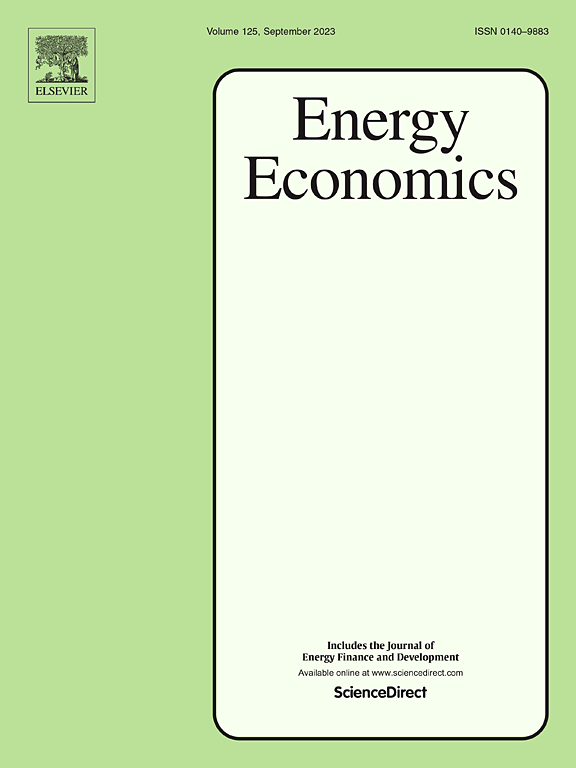Effects of growing-season weather on the dynamic price relationships between biofuel feedstocks
IF 13.6
2区 经济学
Q1 ECONOMICS
引用次数: 0
Abstract
Our study is the first to examine the effects of growing-season weather conditions on both the mean and variance of futures returns in the multipurpose agricultural commodity markets of U.S. soybean oil, Canadian canola, and Malaysian/Indonesian palm oil, based on their significance as substitutes in the global food and energy sectors. We use the vegetation health index (VHI) from major feedstock-growing regions in North America, Brazil, Malaysia, and Indonesia as an indicator of the anticipations of the future crop supply. We assess the impact of current VHI on price dynamics in these markets, we employ the EGARCH-X-DCC framework, which captures the effect of VHI-related news on both returns and short-term volatility in the food and biofuel markets. We also extend our analysis to explore how a crop's VHI, as a slow-moving determinant, influences volatility not only in its own market but also in substitute markets. For this, we use the GARCH-MIDAS-DCC framework, in which one year's worth of VHI acts as the slow-moving component in the MIDAS filter, allowing us to isolate the impact of slowly changing growing conditions on daily volatilities through the long-run component and the dynamic correlations between commodity returns. We find that information about current and longer-term growing-season weather conditions affects both the primary crop market and its substitutes. Furthermore, the broader set of crop condition information increases variability in the long-run correlation between commodity returns.
生长期天气对生物燃料原料动态价格关系的影响
我们的研究首次考察了生长季节天气条件对美国大豆油、加拿大菜籽油和马来西亚/印度尼西亚棕榈油等多用途农产品市场期货回报均值和方差的影响,基于它们在全球食品和能源领域作为替代品的重要性。我们使用来自北美、巴西、马来西亚和印度尼西亚等主要原料种植区的植被健康指数(VHI)作为预测未来作物供应的指标。我们评估了目前VHI对这些市场价格动态的影响,我们采用EGARCH-X-DCC框架,该框架捕捉了与VHI相关的新闻对食品和生物燃料市场的回报和短期波动的影响。我们还扩展了我们的分析,以探索作物的VHI作为一个缓慢移动的决定因素,如何不仅影响其自身市场的波动性,而且影响替代市场的波动性。为此,我们使用GARCH-MIDAS-DCC框架,其中一年的VHI价值作为MIDAS过滤器中的缓慢移动组件,使我们能够通过长期组件和商品回报之间的动态相关性隔离缓慢变化的增长条件对每日波动性的影响。我们发现,有关当前和较长期生长季节天气条件的信息对初级作物市场及其替代品都有影响。此外,更广泛的作物状况信息集增加了商品回报之间长期相关性的可变性。
本文章由计算机程序翻译,如有差异,请以英文原文为准。
求助全文
约1分钟内获得全文
求助全文
来源期刊

Energy Economics
ECONOMICS-
CiteScore
18.60
自引率
12.50%
发文量
524
期刊介绍:
Energy Economics is a field journal that focuses on energy economics and energy finance. It covers various themes including the exploitation, conversion, and use of energy, markets for energy commodities and derivatives, regulation and taxation, forecasting, environment and climate, international trade, development, and monetary policy. The journal welcomes contributions that utilize diverse methods such as experiments, surveys, econometrics, decomposition, simulation models, equilibrium models, optimization models, and analytical models. It publishes a combination of papers employing different methods to explore a wide range of topics. The journal's replication policy encourages the submission of replication studies, wherein researchers reproduce and extend the key results of original studies while explaining any differences. Energy Economics is indexed and abstracted in several databases including Environmental Abstracts, Fuel and Energy Abstracts, Social Sciences Citation Index, GEOBASE, Social & Behavioral Sciences, Journal of Economic Literature, INSPEC, and more.
 求助内容:
求助内容: 应助结果提醒方式:
应助结果提醒方式:


